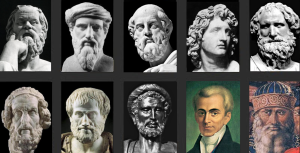Philosopher, Astronomer (4th century BC)
Heraclides descended from a wealthy family from Heraclea Pontica. He was a philosopher and astronomer, the first to propose a mixed geo-heliocentric system of the universe. His vast bibliography, which unfortunately does not survive today, spanned the fields of physics, astronomy, metaphysics and meteorology.
He studied in the Academy of Athens where he became one of Plato’s students and later a student of Aristotle in the Lyceum. In the Academy he befriended Speusippus, the successor of the school. Upon Speusippus’ death, Heraclides was one of the candidates for headmaster of the Academy, but lost to Xenocrates. He returned to his hometown Heraclea where he founded his own philosophic school. Heraclides possessed profound knowledge on Pythagorean philosophy and was a proponent of Demorcitus’ theory of the atom.
Heraclides was active primarily in astronomy. He proposed the mixed helio-geocentric model of the cosmos according to which the sun, the moon and the planets of the solar system rotate around the Earth, except from Venus and Mercury, who orbit the Sun. Heraclides also postulated that the Earth completes a rotation around its axis in 24 hours. He was the first philosopher to hold such a belief. This model proposed by the philosopher is believed to have served as the basis for the astronomical model of Tycho Brahe.
Heraclides was a prolific writer. Like most of his contemporaries, he wrote a book On Nature, a treatise on physics. Furthermore, he wrote the philosophical books On the Pythagoreans, On Hades and on Uranus, On Findings and Zoroaster, books on the philosophy of physics, literary critiques, books on mysticism and books on theurgy or medicine. As a Platonic philosopher, Heraclides endorsed the concept of the immortality of the soul as well as reincarnation. According to him, the soul is made of light (φῶς) and aether (αἰθέρα). It originates from the Galaxy.
Bibliography
- Georgakopoulos, Konstantinos. Ancient Greek Scientists. Georgiades: Athens, 1995. Print.
- J.G. Toomer. Heraclides Ponticus. Encyclopaedia.com. encyclopaedia.com. Web.
- Κάλφας, Βασίλης. Ηρακλείδης Ποντικός. Η Εγκυκλοπαίδεια του Πλάτωνα. N1.xtek.gr. Web.

Don’t publish. I’m back. All of the experts and scholars disagree with me. Guess who agrees with me? Aristarchus of Samos! He PRESERVED the Pythagorean feature of the revolution of the rotating Earth. I became acquainted with a contemporary of Philolaus – a Pythagorean astronomer whom Cicero cited.
LikeLike
Do not publish,. Hello again. Plato’s favorite astronomer was Heraclides. Plato wrote “Timaeus” and described the model. In the 4th century A.D., Calcidius wrote a commentary. Giovanni Schiaparelli (1835-1910) made an error by translating Calcidius that Heraclides proposed a heliocentric model. Bartel van der Waerden (1903-1996) proposed that the sun, the Earth and Venus revolved an empty space. Otto Neugebauer (1899-1990) disagreed with Waerden. Neugebauer carried the day, Waerden is correct in my opinion. Maybe contemporary scholars will review this debate. Aristotle is reported to have purchased every writing of Democritus simply to destroy the writings and erase the legacy of Democritus from history. Aristotle almost succeeded. In my opinion, Aristotle did likewise with the writings of Heraclides
LikeLike
Do not publish. Please fact-check the statement that Heraclides was a student of Aristotle, especially at the Lyceum. Aristotle rejected the model of Heraclides strenuously and stridently. Aristotle might have engaged in a campaign of character assassination of the scientific reputation of Heraclides.
LikeLike
Without a telescope, Heraclides erred regarding the planet Venus. This feature became a characteristic marker(similar to a fingerprint) that allows us to trace the Tychonian model to the proto-Tychonian model in India 1500 A.D. This Indian model of Nilakantha Somayaji revised the model of Aryabhata 500 A.D. The Aryabhata model had the influence of another ancient Greek astronomer, Hipparchus of Nicea who relocated the Earth from the radial center to the eccentric center of the revolution of the planet Mars. The Aryabhata model differed by locating the sun at the radial center for the revolutions for the outer planets. More importantly, Hipparchus inherited a model with the annual revolution of the sun around the Earth. Hipparchus relocated the Earth to the eccentric center in a proposed solution to the absence of the predicted synchronization between the solar solstices and the astral equinoxes. In the Aryabhata model, the sun and the Earth did not move in relation with each other. Nilakantha Somayaji initiated the sun to revolve around the Earth – possibly annually.
LikeLike
Greetings, Heraclides revised the Pythagorean model of Philolaus which postulated an invisible Great Fire at the center of the Cosmos. He solved the mystery of the retrograde episodes of Mars, Jupiter, and Saturn by revolving the ROTATING Earth around this center while the Sun revolve this same center in an outer concentric path. However, only Mercury and Venus were assigned heliocentric orbits. There is a debate on the blogspot LEGAL REBEL between models to replace the Copernican / Aristarchus Heliocentric model.
LikeLike